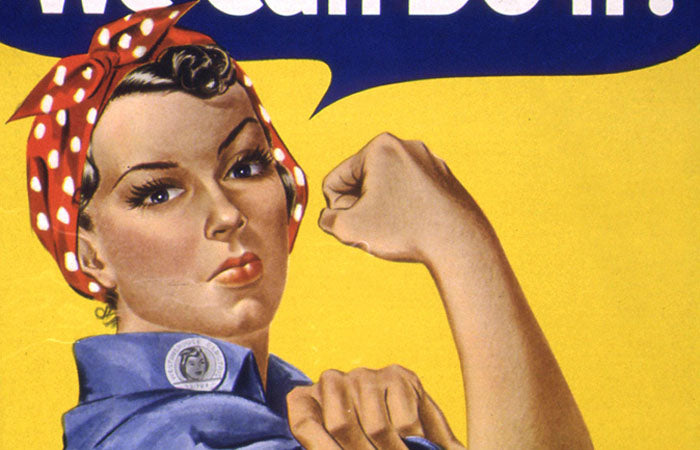
She's got piercing eyes, definition in her muscles and a stern look of determination on her face. She's not afraid to wear a bandanna in her hair or get her hands dirty. She's sexy, sure, but she's no fool--and she can do anything a man can do. She's Rosie the Riveter, a bad-ass American icon, and she's as relevant today as she was when she first emerged into the nation's conscience nearly three centuries ago--and changed the course of history of women in the United States. It was 1942 in America. Franklin D. Roosevelt was president, Jimi Hendrix had just been born and the Rose Bowl was moved from Los Angeles to North Carolina because people feared the Japanese would drop bombs on the field just after kickoff.
Oh, yes: The world was in the throes of WWII.
American men of all ages and abilities had been sent over seas to keep the Nazis and their nefarious leader, the megalomaniac leader of Germany, from taking over the world. The men were certainly on a mobile mission--dropping bombs, invading beaches, doing battle with large- and small-arms. Unfortunately, when the men left to go to war, they left the munitions plants empty. This, of course, posed a problem for a country at war--a country that desperately needed bombs to drop and bullets to fire. With all the men overseas, who was going to run the machines that made the ammunition?
Enter: Women.
 At the time, women were viewed largely viewed as homemakers. If they did work, they were relegated to the secretarial pools (look it up) for large companies or law firms. Mostly, though, they were encouraged to stay at home, clean, cook and make sure their husbands' laundry was properly folded. The problem was, a lot of their husbands were only wearing fatigues, and Uncle Sam was taking care of the washing and drying of the military uniforms. It was time, the collective nation decided, for women to take on more responsibility in the workplace. It was time for women to start making military weapons.
The came from everywhere, the women, and made their way into the machine shops.More than 4 million of them started to do jobs outside of the home for the first times in their lives. They learned new skills, like running presses, machining, mechanics and a whole lot of other stuff that had previously been the bailiwick of the men. Their hands became covered with callouses. Many stopped wearing makeup. They sweated their way through eight-, 10- and 12-hour workdays. They worked their asses off--and many weren't paid what their husbands were paid for doing the same jobs. "Do it for the country," is what they were told. And many were happy to do so. After all, it was either that or start learning to speak German. "Nine!"
At the time, women were viewed largely viewed as homemakers. If they did work, they were relegated to the secretarial pools (look it up) for large companies or law firms. Mostly, though, they were encouraged to stay at home, clean, cook and make sure their husbands' laundry was properly folded. The problem was, a lot of their husbands were only wearing fatigues, and Uncle Sam was taking care of the washing and drying of the military uniforms. It was time, the collective nation decided, for women to take on more responsibility in the workplace. It was time for women to start making military weapons.
The came from everywhere, the women, and made their way into the machine shops.More than 4 million of them started to do jobs outside of the home for the first times in their lives. They learned new skills, like running presses, machining, mechanics and a whole lot of other stuff that had previously been the bailiwick of the men. Their hands became covered with callouses. Many stopped wearing makeup. They sweated their way through eight-, 10- and 12-hour workdays. They worked their asses off--and many weren't paid what their husbands were paid for doing the same jobs. "Do it for the country," is what they were told. And many were happy to do so. After all, it was either that or start learning to speak German. "Nine!"
 Others, needed more motivation. They needed something--someone--to rally around. Which is where Rosie the Riveter came into play. Rosie was tough as nails and soft on the eyes. She worked hard but had a light touch. She was the quintessential all-American woman--and she worked in a machine shop, doing an industrial job to support the brave men serving overseas, fighting on behalf of the country. Rosie burst on to the scene in a song that portrayed her as a selfless, tireless assembly line worker who was part of the collective American war effort. She soon started appearing on posters next to the saying, "We can do it!" It was a message to women that they are strong, capable and important.
Women heard the message and haven't looked back since.
photo credit: DonkeyHotey via photopin cc
photo credit: michal_hadassah via photopin cc
photo credit: michal_hadassah via photopin cc
Others, needed more motivation. They needed something--someone--to rally around. Which is where Rosie the Riveter came into play. Rosie was tough as nails and soft on the eyes. She worked hard but had a light touch. She was the quintessential all-American woman--and she worked in a machine shop, doing an industrial job to support the brave men serving overseas, fighting on behalf of the country. Rosie burst on to the scene in a song that portrayed her as a selfless, tireless assembly line worker who was part of the collective American war effort. She soon started appearing on posters next to the saying, "We can do it!" It was a message to women that they are strong, capable and important.
Women heard the message and haven't looked back since.
photo credit: DonkeyHotey via photopin cc
photo credit: michal_hadassah via photopin cc
photo credit: michal_hadassah via photopin cc
 At the time, women were viewed largely viewed as homemakers. If they did work, they were relegated to the secretarial pools (look it up) for large companies or law firms. Mostly, though, they were encouraged to stay at home, clean, cook and make sure their husbands' laundry was properly folded. The problem was, a lot of their husbands were only wearing fatigues, and Uncle Sam was taking care of the washing and drying of the military uniforms. It was time, the collective nation decided, for women to take on more responsibility in the workplace. It was time for women to start making military weapons.
The came from everywhere, the women, and made their way into the machine shops.More than 4 million of them started to do jobs outside of the home for the first times in their lives. They learned new skills, like running presses, machining, mechanics and a whole lot of other stuff that had previously been the bailiwick of the men. Their hands became covered with callouses. Many stopped wearing makeup. They sweated their way through eight-, 10- and 12-hour workdays. They worked their asses off--and many weren't paid what their husbands were paid for doing the same jobs. "Do it for the country," is what they were told. And many were happy to do so. After all, it was either that or start learning to speak German. "Nine!"
At the time, women were viewed largely viewed as homemakers. If they did work, they were relegated to the secretarial pools (look it up) for large companies or law firms. Mostly, though, they were encouraged to stay at home, clean, cook and make sure their husbands' laundry was properly folded. The problem was, a lot of their husbands were only wearing fatigues, and Uncle Sam was taking care of the washing and drying of the military uniforms. It was time, the collective nation decided, for women to take on more responsibility in the workplace. It was time for women to start making military weapons.
The came from everywhere, the women, and made their way into the machine shops.More than 4 million of them started to do jobs outside of the home for the first times in their lives. They learned new skills, like running presses, machining, mechanics and a whole lot of other stuff that had previously been the bailiwick of the men. Their hands became covered with callouses. Many stopped wearing makeup. They sweated their way through eight-, 10- and 12-hour workdays. They worked their asses off--and many weren't paid what their husbands were paid for doing the same jobs. "Do it for the country," is what they were told. And many were happy to do so. After all, it was either that or start learning to speak German. "Nine!"
 Others, needed more motivation. They needed something--someone--to rally around. Which is where Rosie the Riveter came into play. Rosie was tough as nails and soft on the eyes. She worked hard but had a light touch. She was the quintessential all-American woman--and she worked in a machine shop, doing an industrial job to support the brave men serving overseas, fighting on behalf of the country. Rosie burst on to the scene in a song that portrayed her as a selfless, tireless assembly line worker who was part of the collective American war effort. She soon started appearing on posters next to the saying, "We can do it!" It was a message to women that they are strong, capable and important.
Women heard the message and haven't looked back since.
photo credit: DonkeyHotey via photopin cc
photo credit: michal_hadassah via photopin cc
photo credit: michal_hadassah via photopin cc
Others, needed more motivation. They needed something--someone--to rally around. Which is where Rosie the Riveter came into play. Rosie was tough as nails and soft on the eyes. She worked hard but had a light touch. She was the quintessential all-American woman--and she worked in a machine shop, doing an industrial job to support the brave men serving overseas, fighting on behalf of the country. Rosie burst on to the scene in a song that portrayed her as a selfless, tireless assembly line worker who was part of the collective American war effort. She soon started appearing on posters next to the saying, "We can do it!" It was a message to women that they are strong, capable and important.
Women heard the message and haven't looked back since.
photo credit: DonkeyHotey via photopin cc
photo credit: michal_hadassah via photopin cc
photo credit: michal_hadassah via photopin cc
